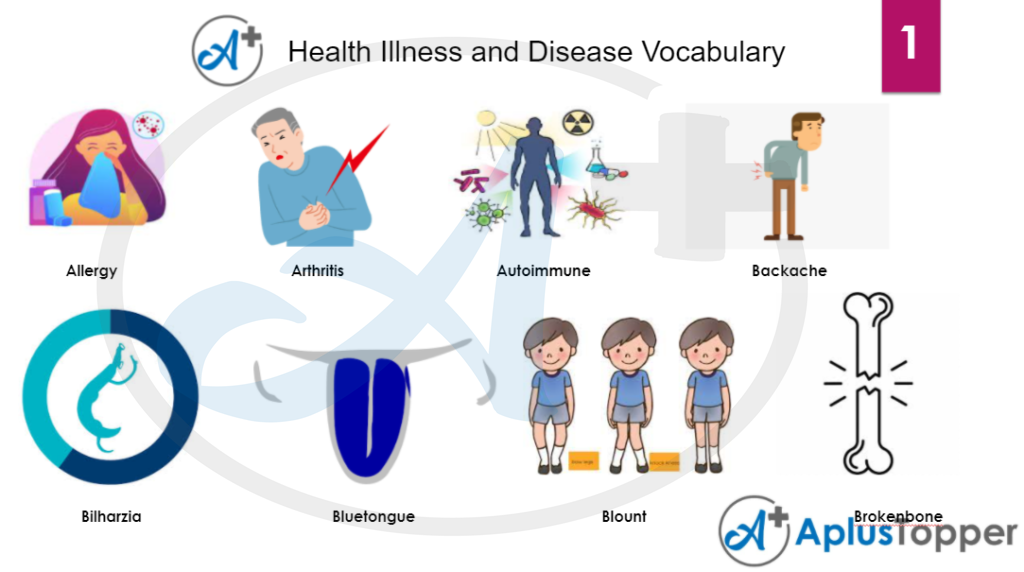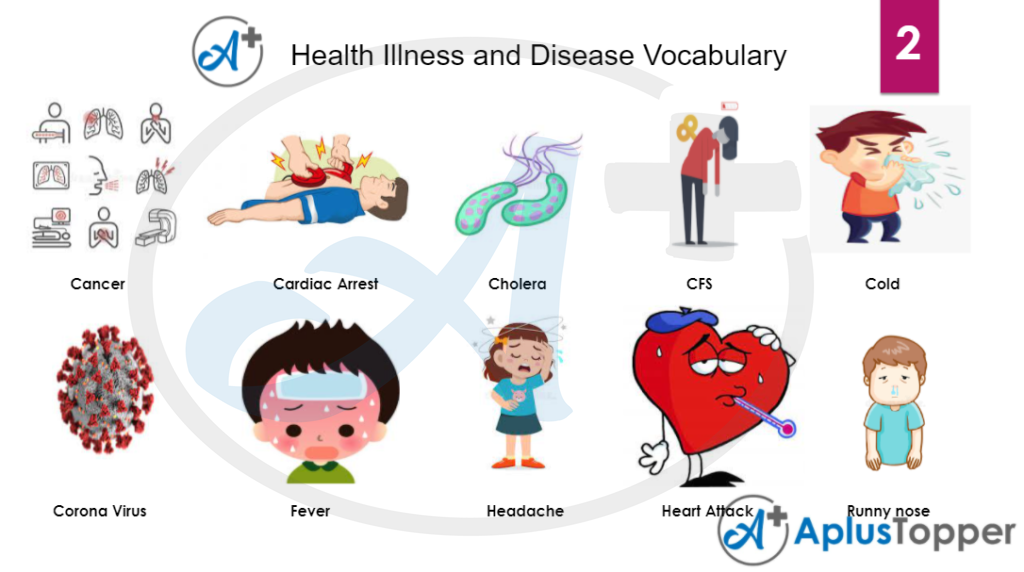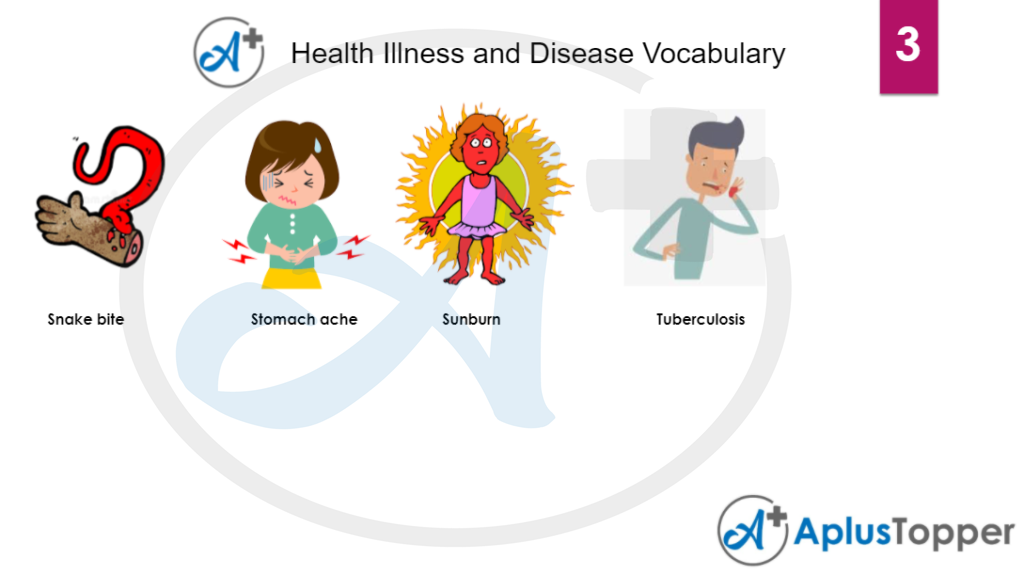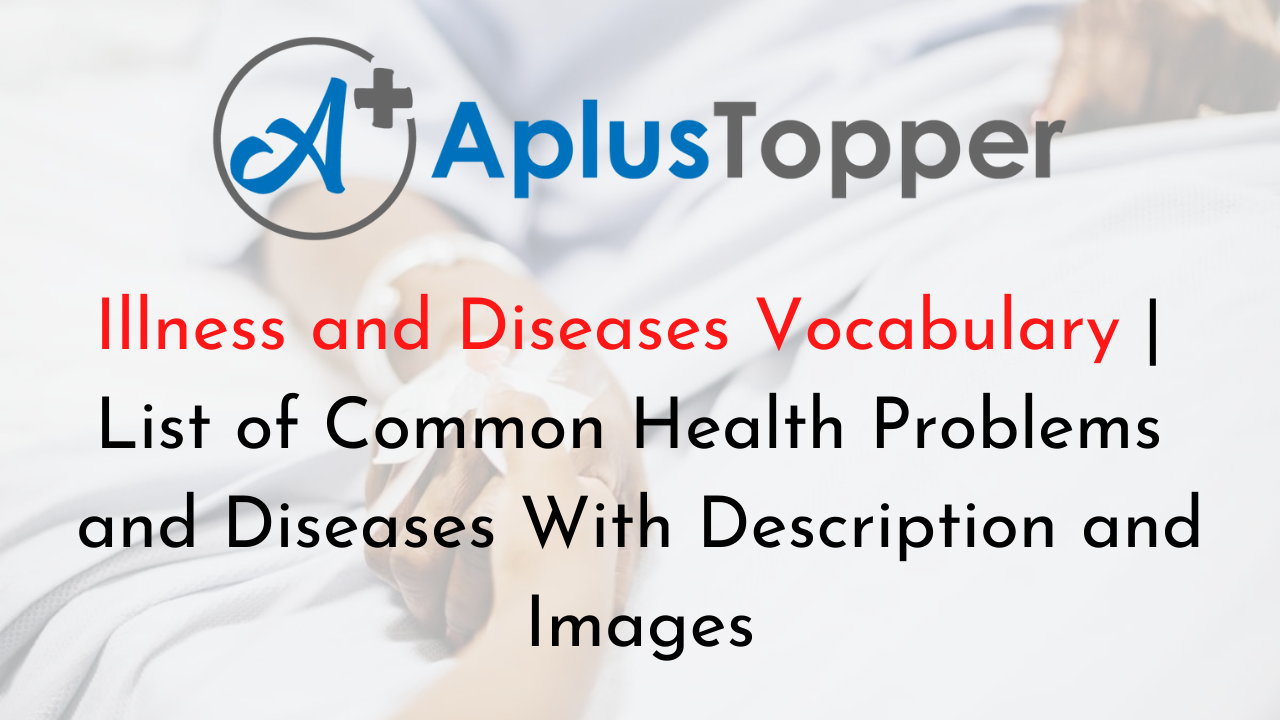Illness and Diseases Vocabulary: Most of the health illnesses are due to the change in the climate. Learn the list of illnesses and diseases vocabulary from this article. You can find useful information on common diseases with pictures here. Illness is a synonym for disease. List of illnesses and diseases vocabulary about health problems with meaning for each and every disease. Some of the diseases that are discussed here are cancer, cold, diabetes, heart attack, and so on.
Study the most important English Vocabulary Words identified by our experts and learn the right vocabulary to use in your day to day conversations.
Health Illness and Disease Vocabulary
- Abnormality
- Acute
- Aggressiveness
- ailment
- Allergy
- Arthritis
- Attack
- Autoimmune disease
- Backache
- Bilharzia
- Bluetongue
- Blount
- Broken bone
- Calculus
- Cancer
- Cardiac Arrest
- CFS
- CGD
- Chagas Disease
- Cholera
- Chronic
- CMV
- Coated
- Cold
- Common Variable Immunodeficiency
- Comorbid
- Corona Virus
- Cough
- Diarrhea
- Fever
- Flu
- Headache
- Leukemia
- Malaria
- Pneumonia
- Pyelitis
- Runny nose
- Snakebite
- Stomachache
- Sunburn
- Tetanus
- Tuberculosis
- Typhoid
List of Health Illness and Disease Names in English
The English names of health illnesses and diseases are shown in the below section.

An abnormal feature, characteristic, or state of being abnormal.
An acute is a disease that appears suddenly and lasts for a short period of time. Examples of acute diseases are the influenza virus and the cold.
Aggressiveness is a mode of communication and behavior where one expresses their feelings or emotions, needs.
The ailment is a physical disorder or illness. The process of identifying a disease, condition, or injury from its sign and symptoms.
An allergy is a medical condition that causes you to feel sick when you eat a particular substance.
Arthritis disease is the swelling and tenderness of one or more of your joints. Joint pains are the symptoms of arthritis.
The most common cause of a heart attack is a blockage in one of the arteries near the heart. Coronary Artery Disease is the main cause of heart attack.
A disease in which the body’s immune system attacks healthy cells like your joints or skin.
An extended pain in the back. Backache occurs due to muscle or ligament strain. It may be caused due to heavy lifting, constant strain on your back, etc.
Bilharzia is also called Schistosomiasis. Bilharzia is caused by infection with freshwater worms in certain tropical and subtropical countries. The symptoms include blood stool, diarrhea, abdominal pain in the urine.
Bluetongue is a viral disease caused by the Bluetongue virus (BTV). Bluetongue is a noncontagious, insect-borne, viral disease of ruminants, mainly goats, buffalo, deer, yaks, cattle, etc.
Blount is a growth disorder of the shin bone in which the lower leg turns inward, making it look like a bowleg. The exact cause of Blount’s disease is unknown.
Broken bone disease is also called Osteogenesis imperfecta. It is a genetic disorder that causes weak bones that break easily in addition to other symptoms.

Calculus is often called a stone. Kidney stones are hard deposits made of minerals and salts that form inside your kidneys. Kidney stones occur in 1 to 25 people at some time in their life.
Cancer is a serious disease caused by an uncontrolled division of abnormal cells that kill normal body cells. There are different types of cancer they are blood cancer, lung cancer, bone cancer, etc.
Cardiac Arrest occurs when a diseased heart’s electrical system malfunctions. It is also caused by the extreme slowing of the heart’s rhythm such as ventricular tachycardia or ventricular fibrillation.
CFS is known as Chronic Fatigue Syndrome. It is a disorder characterized by extreme fatigue or tiredness that does not go away with rest. CFS is a serious long-term illness that affects many-body systems.
CGD means Chronic Granulomatous Disease that is an inherited disorder that occurs when a type of WBC that usually helps your body fight infections does not work properly.
Chagas is a tropical parasitic disease caused by Trypanosoma cruzi. It is also known as American trypanosomiasis that is mostly spread by insects like bugs.
Cholera is an infectious disease that causes severe watery diarrhea that leads to dehydration and even death. It is spread by eating or drinking food or poop of an infected person.
A chronic condition is a human health condition or disease that is long-lasting. It lasts for more than three months. The common chronic diseases are heart disease, cancer, stroke, diabetes, etc.
CMV or Cytomegalovirus is a common virus that causes problems in healthy people of all ages.
Coats disease is a rare eye disorder involving abnormal development of blood vessels in the retina. It affects the retina which is the tissue at the back of the eye that detects color and eye.
Cold is a viral infection of the nose and throat. A common cold can be caused by many different types of viruses. Symptoms of cold are runny nose, sneezing, fever. It is a self-limited contagious disease.
Common Variable Immunodeficiency
Common Variable Immunodeficiency is frequently diagnosed primary immunodeficiencies seen in adults. It is a disorder that impairs the immune system.
Comorbidity is more than one disease or medical condition that is simultaneously present in a patient.
Coronavirus disease is an infectious disease caused by the SARS-CoV-2 virus. It can be spread from an infected person’s mouth or nose in small liquid particles when they sneeze, cough, breathe, etc.
Cough is an illness that irritates your throat or airways. An occasional cough is normal and healthy. Coughing is a standard way of clearing your throat.
Diarrhea is the second leading cause of death in children under five years old. It is preventable and treatable through safe drinking water, sanitation, and hygiene.
Fever is a common disease that occurs due to change in climate conditions. A fever is a temporary increase in your body temperature. It is a sign that something out of the ordinary is going on in your body. There are four types of fever as Intermittent fever, Remittent fever, Hectic fever, continuous fever.
Flu is also called influenza. It is a common viral infection that can be deadly, especially in high-risk groups. The symptoms of flu include fever, muscle aches, cough, congestion, runny nose, chills, headache, etc.
A migraine is a headache that causes severe pain or a pulsing sensation. It occurs usually on one side of the head. This type of headache usually develops in people who have episodic headache disorder.
Leukemia is also called blood cancer. Leukemia is a cancer of blood-forming tissues including bone marrow. The organs affected by leukemia are the liver, central nervous system, lymph nodes, and other organs.
Malaria is a disease caused by a parasite. Malaria is common in tropical and subtropical countries. The parasite is spread to humans through mosquito bites.
Pneumonia is an infection that inflames your lungs’ air sacs that may be caused by bacteria, viruses, or fungi. The air sacs will be filled or pus causing symptoms likewise cough, fever and trouble breathing.
Pyelitis is a bacterial infection of the renal pelvis. It is a bladder infection or urinary tract infection that is responsible for pyelitis.
The runny nose is a viral infection that is the most common cause of a stuffy nose. A runny nose can be caused by anything that irritates the nasal tissues.

An injury caused by a bite from a snake is known as snakebite. Snakebite can be harmful to life if the snake is poisonous. The symptoms of snakebite include swelling, redness, or bleeding at the place where the snake bite took place. Emergency medical treatment is needed for the patient.
Stomachache or stomach pain is an abdominal pain that includes indigestion after eating, gallstones, gas, pregnancy, appendicitis, ulcers, gastritis, etc.
Sunburn is red, painful skin that feels hot to the touch. A type of skin burn results from too much exposure to sunlight. The skin may also blister. Treatment includes pain relievers and creams to ease itching.
Tetanus is an infection caused by bacteria called Clostridium tetani. It is a serious bacterial infection that causes painful muscles contractions and also leads to death. It is a vaccine-preventable disease.
Tuberculosis is well known as TB is caused by bacteria called Mycobacterium tuberculosis. This bacteria affects the lungs, but TB bacteria can attack any part of the body such as the kidney, spine, and brain.
Typhoid is a bacterial infection. Typhoid is a fever that causes similar symptoms. People with this disease have fevers that can be high as 103 to 104 degrees Fahrenheit. It occurs in multiple organs in your body.
